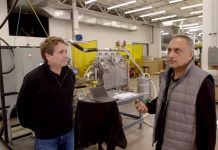Thomas Edison is one of the most widely known inventors of his time and his name is synonymous with many great inventions that we still use today. One of his favorite inventions, however, was the phonograph. While he was trying to find ways to improve the telephone and the telegraph, Edison discover that sound could be recorded on tinfoil-coated cylinders. He created a phonograph that initially had two needles so that one could record and one could play the sounds. This occurred in 1877.
Here is a brief overview of the other inventions that Thomas Edison has patented – after all, he has almost 1,100 that are credited to him!
1. The Carbon Microphone
All telephones needed a microphone to capture vocal sounds in order to transmit them across the distance. In 1877-78, Edison invented a carbon microphone that was used with Bell receivers well until the 1980’s. A Federal Court ruled in 1892 after extensive litigation that Edison was the rightful inventor awarded with the patent and this microphone was used in radio broadcasting for several years as well.
2. Incandescent Light
Many believe that Thomas Edison invented the light bulb, but that isn’t entirely accurate. Edison didn’t invent the first light bulb, but instead developed the first incandescent light that was commercially practical to use. The problem with the first light bulbs was that they had incredibly short lifespans and they were expensive to produce, making it difficult to take advantage of the technology. Edison improved the design to use a carbon filament initially and then discovered that carbonized bamboo could last for over 1,200 hours.
3. Power Distribution
Once there was a light bulb that could be used commercially, there needed to be a way to distribute power to those light bulbs in a reliable fashion. In 1880, Edison patented a system for electrical distribution that utilized overhead wires from a central generation station that produced 110 volts of direct current. This first utility provided power to 59 homes and over the years Edison worked to improve the efficiency of power generation so that more customers could be served.
4. The Commercial Fluoroscope
The technology was available for machines to take x-rays of the human body, called radiographs, but it was very expensive and rarely used because the images were very faint. Edison discovered that calcium tungstate screens produced better images and much of the fundamentals of his work are still used today even though Edison abandoned his research. During one test, Edison almost lost all of his eyesight and his assistant, Clarence Dally, was exposed to a lethal dose of radiation.
5. Motion Picture Cameras
Thanks to his work as a telegraph operator early in life, Edison had a grasp of the networking puzzle that electricity required. That helped him to create a type of phonograph that could record pictures as well, which he called the kinetograph. This allowed for moving images to be captured, allowing for the movie industry to develop.
Strong proponent of individual liberty and free speech. My goal is to present information that expands our awareness of crucial issues and exposes the manufactured illusion of freedom that we are sold in America. Question everything because nothing is what it seems.



















